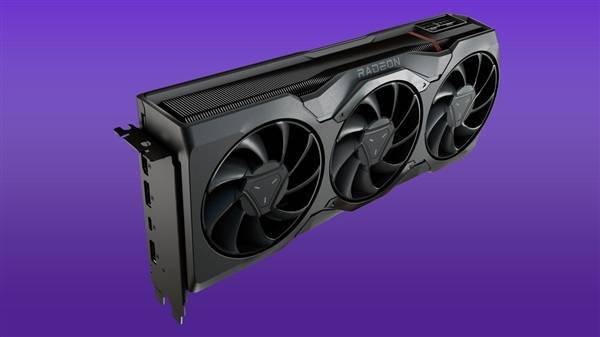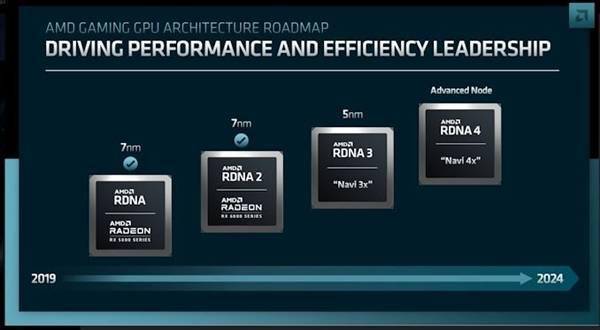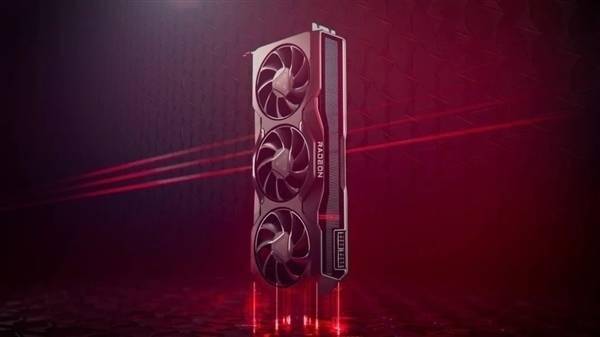 Technology peripherals
Technology peripherals
 AI
AI
 Full-blooded 18,000-core AMD RX 8000 graphics card will bet on ray tracing and AI: tough RTX 50
Full-blooded 18,000-core AMD RX 8000 graphics card will bet on ray tracing and AI: tough RTX 50
Full-blooded 18,000-core AMD RX 8000 graphics card will bet on ray tracing and AI: tough RTX 50
Quick Technology News on June 8th, AMD’s RDNA architecture GPU has developed for three generations. Last year’s RX 7000 series used the latest RDNA3 architecture, claiming that the performance per watt has increased by 50%, but the final performance is hard to describe.
The performance of the flagship RX 7900 XTX is not only incomparable with the RTX 4090 of its competitors, but also cannot even beat the RTX 4080. If light tracing is turned on, the gap will be even greater. It is normal to be ahead by more than 50% in performance.

The FSR 3 technology, which is regarded as the killer feature, was originally designed to benchmark DLSS 3, but it has not been officially released until now, and the number of games supported is incomparable with N cards.
In addition to game performance, RDNA3 has no presence in AI performance. The energy efficiency is said to be greatly improved. The TDP power consumption of 335W is 95W lower than the 450W of RTX 4090. In practice, there is no advantage.
In short, RDNA3 is very good and powerful in theory, but compared with the RTX 40 series, it is really hard to accept. N-cards are criticized for being expensive, but besides being expensive, they have other advantages.

A fan’s hope can only be the next generation RDNA4 architecture, which is the RX 8000 series. According to the schedule, it should be released in 2024. It is unlikely that the process technology will be upgraded to 3nm. It should be an improved version of the 5nm 4nm process. , but it does not rule out AMD’s radical 3nm process.
More importantly, the design ideas of RDNA4 will change. NVIDIA has successfully proved that light tracing and AI are important. AMD has to follow. The new architecture will be greatly changed, the RT light tracing unit will be reset, and the AI performance will also change. It will be the highlight - after AMD acquired Xilinx, there is no shortage of advanced AI technology and ecology.
RDNA4 will continue to use the small chip design of RDNA3, and the scale of the computing core GCD and IO core MCD will be increased. Up to 144 sets of CU units, 18432 cores at full health, and the video memory can reach 32GB, or 48GB , depends on the MCD quantity.
The calculation scale of RNDA4 has been increased by 50%, and the frequency has been optimized to 3.5GHz. Theoretically, the performance has doubled. However, the figures in this regard are not accurate. Some say that the performance has been improved by at least 50%. There is also a 50% improvement in energy efficiency to ensure that power consumption does not get out of control.
If you remember the early revelations of RDNA3 last year, you should understand that this RDNA4 is the full-blooded version of the original RNDA3. We can only hope that AMD will really make up its mind to develop high-performance graphics cards.
Nvidia will also launch the RTX 50 series in 2024, codenamed Blackwell. It is said that the performance will be greatly improved. Compared with the current improvement of 60%, it will not be a problem. The pressure of AMD RX 8000 to surpass the RTX 50 is not small at all.

The above is the detailed content of Full-blooded 18,000-core AMD RX 8000 graphics card will bet on ray tracing and AI: tough RTX 50. For more information, please follow other related articles on the PHP Chinese website!

Hot AI Tools

Undresser.AI Undress
AI-powered app for creating realistic nude photos

AI Clothes Remover
Online AI tool for removing clothes from photos.

Undress AI Tool
Undress images for free

Clothoff.io
AI clothes remover

Video Face Swap
Swap faces in any video effortlessly with our completely free AI face swap tool!

Hot Article

Hot Tools

Notepad++7.3.1
Easy-to-use and free code editor

SublimeText3 Chinese version
Chinese version, very easy to use

Zend Studio 13.0.1
Powerful PHP integrated development environment

Dreamweaver CS6
Visual web development tools

SublimeText3 Mac version
God-level code editing software (SublimeText3)

Hot Topics
 1664
1664
 14
14
 1423
1423
 52
52
 1318
1318
 25
25
 1269
1269
 29
29
 1248
1248
 24
24
 Getting Started With Meta Llama 3.2 - Analytics Vidhya
Apr 11, 2025 pm 12:04 PM
Getting Started With Meta Llama 3.2 - Analytics Vidhya
Apr 11, 2025 pm 12:04 PM
Meta's Llama 3.2: A Leap Forward in Multimodal and Mobile AI Meta recently unveiled Llama 3.2, a significant advancement in AI featuring powerful vision capabilities and lightweight text models optimized for mobile devices. Building on the success o
 10 Generative AI Coding Extensions in VS Code You Must Explore
Apr 13, 2025 am 01:14 AM
10 Generative AI Coding Extensions in VS Code You Must Explore
Apr 13, 2025 am 01:14 AM
Hey there, Coding ninja! What coding-related tasks do you have planned for the day? Before you dive further into this blog, I want you to think about all your coding-related woes—better list those down. Done? – Let’
 AV Bytes: Meta's Llama 3.2, Google's Gemini 1.5, and More
Apr 11, 2025 pm 12:01 PM
AV Bytes: Meta's Llama 3.2, Google's Gemini 1.5, and More
Apr 11, 2025 pm 12:01 PM
This week's AI landscape: A whirlwind of advancements, ethical considerations, and regulatory debates. Major players like OpenAI, Google, Meta, and Microsoft have unleashed a torrent of updates, from groundbreaking new models to crucial shifts in le
 GPT-4o vs OpenAI o1: Is the New OpenAI Model Worth the Hype?
Apr 13, 2025 am 10:18 AM
GPT-4o vs OpenAI o1: Is the New OpenAI Model Worth the Hype?
Apr 13, 2025 am 10:18 AM
Introduction OpenAI has released its new model based on the much-anticipated “strawberry” architecture. This innovative model, known as o1, enhances reasoning capabilities, allowing it to think through problems mor
 A Comprehensive Guide to Vision Language Models (VLMs)
Apr 12, 2025 am 11:58 AM
A Comprehensive Guide to Vision Language Models (VLMs)
Apr 12, 2025 am 11:58 AM
Introduction Imagine walking through an art gallery, surrounded by vivid paintings and sculptures. Now, what if you could ask each piece a question and get a meaningful answer? You might ask, “What story are you telling?
 3 Methods to Run Llama 3.2 - Analytics Vidhya
Apr 11, 2025 am 11:56 AM
3 Methods to Run Llama 3.2 - Analytics Vidhya
Apr 11, 2025 am 11:56 AM
Meta's Llama 3.2: A Multimodal AI Powerhouse Meta's latest multimodal model, Llama 3.2, represents a significant advancement in AI, boasting enhanced language comprehension, improved accuracy, and superior text generation capabilities. Its ability t
 How to Add a Column in SQL? - Analytics Vidhya
Apr 17, 2025 am 11:43 AM
How to Add a Column in SQL? - Analytics Vidhya
Apr 17, 2025 am 11:43 AM
SQL's ALTER TABLE Statement: Dynamically Adding Columns to Your Database In data management, SQL's adaptability is crucial. Need to adjust your database structure on the fly? The ALTER TABLE statement is your solution. This guide details adding colu
 Pixtral-12B: Mistral AI's First Multimodal Model - Analytics Vidhya
Apr 13, 2025 am 11:20 AM
Pixtral-12B: Mistral AI's First Multimodal Model - Analytics Vidhya
Apr 13, 2025 am 11:20 AM
Introduction Mistral has released its very first multimodal model, namely the Pixtral-12B-2409. This model is built upon Mistral’s 12 Billion parameter, Nemo 12B. What sets this model apart? It can now take both images and tex



